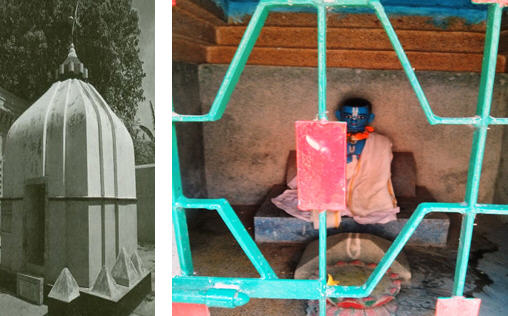Not long after the time of Caitanya Mahaprabhu, a king who was a Deity hater was going around and smashing Deities in temples. When the people of Remuna heard he was coming, they hid Gopinatha in a pond three miles away. The king was upset that he could not find Gopinatha, so he struck and partially broke Ramacandi, the Durga deity.
Meanwhile, a great devotee named Rasikananda received an order in a dream to excavate the pond where Gopinatha had been hidden. He recovered the Gopinatha Deity, built a temple for Him, and took charge of His worship.

Rasikananda was the foremost disciple of Syamananda, who had helped transport the writings of the Gosvamis from Vrndavana to Bengal. Syamananda had spread Krsna consciousness extensively in Orissa, where Rasikananda had become his disciple.
When Rasikananda decided it was time to leave the world, he went into the Gopinatha temple and disappeared. He had been performing sankirtana in the temple courtyard with seven of his associates, and now his associates were so overwhelmed by spiritual separation that they too gave up their bodies and entered the spiritual world.
The samadhis (tombs) of Rasikananda and these associates stand outside the temple. Each spring the people of Remuna hold a twelve-day festival to commemorate the passing of Rasikananda.
Visiting Remuna
The best way to get to Remuna from Calcutta is to take a train from Howrah station to Baleshwar, about a five-hour trip, depending on the train. From Baleshwar one has to travel twelve kilometers to Remuna by taxi, auto riksha or bus.
There’s a small guesthouse at the Gopinatha temple, and there are some good hotels in Baleshwar. You can get prasadam at the Gopinatha temple at midday and in the evening. You reserve your meal by paying in advance. You’ll get a plate of rice, dal, chutney, and two vegetable dishes.
The temple’s famous spiced condensed milk is available, in afternoon and evening, in small, medium, and large pots.
Tumultuous Worship
Evening Arti (worship) at the Ksira-cora Gopinatha temple is spectacular. Just before 7:00 P.M. the curtain draws closed. Two pujaris in the Deity room bang gongs, someone in the courtyard bangs a big drum, and a kirtana group sings and plays mrdanga drums and karatalas (hand cymbals), all together making a tremendous sound. At seven the curtain is whisked open. Everyone outside the Deity room offers obeisances, and the kirtana picks up again with full volume. The pujari offers incense and camphor while a second pujari stands behind him waving a camara (yak-tail whisk). Although the temple always has electricity, during the arati a man holds a traditional torch of oil-soaked cloth.
After the pujari has offered the incense, the curtain is closed while he lights the ghee lamp. Meanwhile the kirtana goes on, and when the door opens, the kirtana becomes intense bang! bang! bang!
The pujari offers the ghee lamp and then water in a conch shell. When he finishes, he walks through the kirtana courtyard, throwing the water on both sides, as all the devotees offer obeisances to get the water on their heads. The arati lasts about ten minutes.